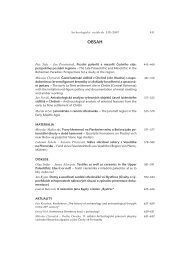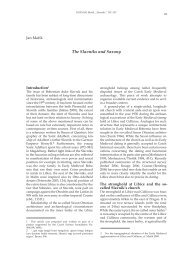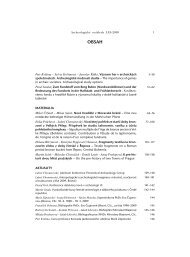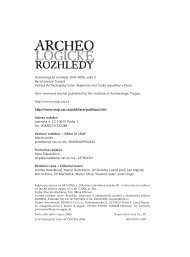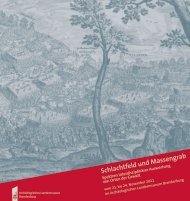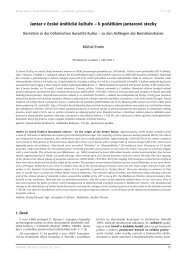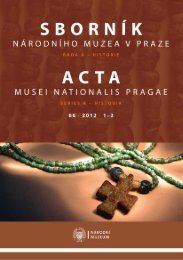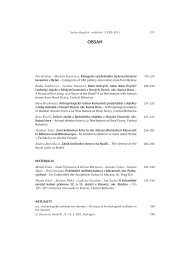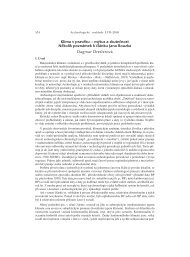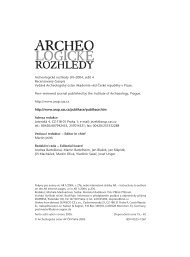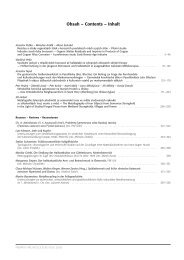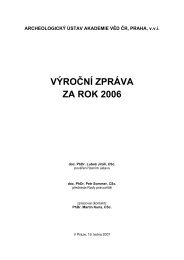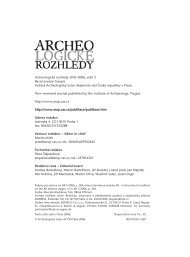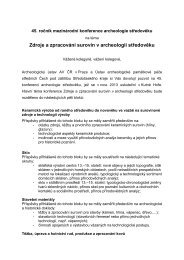contents (.pdf)
contents (.pdf)
contents (.pdf)
Create successful ePaper yourself
Turn your PDF publications into a flip-book with our unique Google optimized e-Paper software.
My Things Changed Things<br />
0<br />
Social Development and Cultural Exchange in Prehistory,<br />
Antiquity, and the Middle Ages<br />
Petra Maříková Vlčková<br />
– Jana Mynářová –<br />
Martin Tomášek (eds.)<br />
Charles University in Prague, Faculty of Arts<br />
Institute of Archaeology of the Academy of Sciences of the Czech Republic, Prague, v.v.i.<br />
Prague 2009
Reviewed by Lumír Poláček and Jana Součková<br />
The publication of this volume was financed from the funds of the Research Plan<br />
of the Czech Institute of Egyptology MSM 0021620826, “The Exploration of the Civilization<br />
of Ancient Egypt”.<br />
© Charles University in Prague, Faculty of Arts – Institute of Archaeology of the Academy of<br />
Sciences of the Czech Republic, Prague, v.v.i., 2009<br />
Translations: Jana Klíčová, Petra Maříková Vlčková, Markéta Larsenová, Wolf B. Oerter,<br />
Lubica Zelenková, 2009<br />
Photography: osobní archivy autorů a zúčastněných institucí / personal archives<br />
of the authors and participating institutions, 2009<br />
Illustrations: Luděk Galuška, Jan Mařík, Petra Maříková Vlčková, Ivan Pavlů,<br />
Jaroslav Řídký, 2009<br />
Type-setting layout: AGAMA ® poly-grafický atelier, s.r.o.<br />
ISBN 978-80-7308-279-6<br />
ISBN 978-80-87365-18-2
THE UNBELIEVABLE 60 th BIRTHDAY OF PETR CHARVÁT<br />
Jiří Sláma<br />
One can hardly avoid the impression that the hectic way of life of today’s hurried<br />
times seems to deny the justness of F. Braudel’s reflections about several categories of<br />
historical time, of which we are left only with the fastest-running one. How else are we<br />
to explain the fact that some of our professional colleagues, whose first steps on the<br />
field of historical investigation we had quite recently observed with keen interest, have<br />
already reached the age when scholars are given a collected volume at the occasion of<br />
their life’s jubilee? This holds true also of our dear colleague Petr Charvát (*January 12,<br />
1949 in Prague). The composition of the collected volume dedicated to his sixtieth<br />
birthday is quite unusual it terms of its content, one could almost say it is exceptional.<br />
The authors of the individual contributions range from scholars of the Ancient Near<br />
East over Egyptologists to specialists in Early Medieval Bohemia and Moravia. The<br />
scope of interest of our honoree covers all these parts of early history. The range of his<br />
interests is indeed admirable and at the same inspiring. In the course of his investigation<br />
of various archaeological and historical problems, P. Charvát has always strived to<br />
find monuments and phenomena (for example in the area of religious concepts or<br />
commercial relationships), which had connected these distant regions and differing<br />
thought systems in the past.<br />
The formation of the personality of our honoree was undoubtedly to a large extent<br />
influenced by the exceptional intellectual environment of his family. His future professional<br />
focus as well as scholarly interests stemmed primarily from his studies at the<br />
Charles University in Prague. The greater part of his studies took place already in the<br />
complicated period after the year 1968, when the newly created state power, based on<br />
the support of alien tanks that invaded our country, denied for nonsensical ideological<br />
and power reasons any scholarly contacts with the western world. Only a few university<br />
disciplines could stand up to these for scholarly research so devastating tendencies.<br />
These included also prehistory and cuneiform studies, where the honoree graduated in<br />
the year 1973. He was also lucky to have been able to acquaint himself with university<br />
life free from nonsensical political pressure in the course of one academic year of his<br />
studies, although in order to attain this experience, he had to travel to the distant Lagos<br />
in Nigeria.<br />
After graduation, P. Charvát gradually extended his knowledge in the course of<br />
a scholarship at the Czech Institute of Egyptology and, following that, postgraduate<br />
internship at the Archaelogical Institute in Prague. He remained loyal to this institution<br />
in the course of the ensuing years, although a greater part of his workload has gradually<br />
shifted to other workplaces. These included above all the Oriental Institute in Prague<br />
and then some university departments, of which the Department of Near Eastern Studies<br />
of the University of West Bohemia in Pilsen became his home institution.<br />
When contacts with foreign countries were enabled after the political changes of<br />
1989, our honoree used his opportunities to the full. He undertook several scholarships<br />
in France, Berlin, twice he stayed at the University of Pennsylvania in Philadelphia and<br />
he also studied at the University of Cambridge. He also had the opportunity to take part<br />
at several foreign archaeological expeditions. These included above all the exploration<br />
3
of the Buddhist temple in Anuradhapura at Sri Lanka, undertaken in terms of<br />
a UNESCO campaign, and the British archaeological expedition at Djemdet Nasr near<br />
Baghdad. P. Charvát is also a member of the Spanish archaeological mission in Turkey.<br />
The honoree’s deep knowledge and wide overview of specialized literature allowed<br />
him to gradually publish a number of scholarly articles and monographs, important<br />
both thematically and in terms of their content, on the basis of which he first attained<br />
the academic title PhDr. (in 1975), several years later the scholarly title of candidate of<br />
sciences CSc. (in 1980) and another fifteen years later (in 1995) also the highest scholarly<br />
title awarded in our country, doctor of historical sciences (DrSc.). In the same year, he<br />
habilitated at the faculty of arts of Masaryk University in Brno in the discipline of Slavic<br />
archaeology, receiving the title of Assistant Professor.<br />
Since the year 1993, Petr Charvát has been lecturing at several Czech universities. He<br />
is an acknowledged and erudite university teacher. At first he lectured at the Pedagogical<br />
Faculty of the Charles University in Prague, later he moved to the University of West<br />
Bohemia in Pilsen. His lectures and the seminars he directs mostly concentrate on the<br />
wide aspects of the cultures of the Ancient Near East. As a visiting professor, P. Charvát<br />
has also given lectures concerning problems of the archaeology of Early Medieval<br />
Europe at the Faculties of Arts in Brno and Prague.<br />
Both in Czech and international scholarly circles, P. Charvát is known above all as the<br />
author of a vast number of scholarly articles and several monographs. Many of these<br />
have been published by prestigious publishers. Charvát’s bibliography includes both<br />
works covering the problems of the historical development of a larger area in the course<br />
of a longer period of time (for example his books on the most ancient history of Mesopotamia<br />
or about the beginnings of the Czech state), but also studies dedicated to partial<br />
problems. All his works are characterized by his critical approach, excellent knowledge<br />
of material culture, epigraphic sources and corresponding scholarly literature as<br />
well as an ability to reach new approaches and interpretations. With their frequently<br />
non-traditional approaches to the problems addressed, Charvát’s works stimulate<br />
thought and discussion. All these aspects of the works of the honoree are, however,<br />
well-known and it is unnecessary to reiterate them again.<br />
What to say in conclusion? Under no circumstances should we repeat the cliché of<br />
wishing all good for the ensuing years. This would not do for the vital Petr Charvát<br />
(whose 60 years of age appear to me rather like a mistake in his birth certificate). And<br />
thus we can wish him (and, rather selfishly, also ourselves) that he might publish as<br />
much an in such a way as he had done until now. We are already looking forward for his<br />
new works.<br />
4
MY THINGS CHANGED THINGS<br />
Social Development and Cultural Exchange in Prehistory,<br />
Antiquity, and the Middle Ages<br />
“But most cultural transfers were the work of anonymous carriers. So many were<br />
they, some moving quickly, others so slowly, that it is almost impossible to find one’s<br />
way through this immense baggage hall in perpetual confusion. For every piece of cultural<br />
baggage recognized, a thousand are untraceable: identification labels are missing<br />
and sometimes the <strong>contents</strong> or their wrappings have vanished too.”<br />
Braudel, F., The Mediterranean and the Mediterranean World in the Age of Philip II.<br />
Volume II. London: University of California Press 1973, 761.<br />
When Peter Roger Stuart Moorey used this quotation to open his chapter on tracing<br />
the roots of cultural transfers between Egypt and Mesopotamia (in: Rowlands, M. – Larsen,<br />
M. – Kristianses, K. (eds.): Centre and Periphery in the Ancient World. Cambridge:<br />
Cambridge University Press 1987, 36), he precisely defined one of the thorniest problems<br />
not only of archaeology but also of history or any other social science. The dynamics<br />
of society and its material culture development, intercultural exchanges, and legacies of<br />
ancient cultures represent themes that can be observed diachronically throughout the<br />
entire history of mankind. The following, analyzing, and evaluating of these processes<br />
and their understanding can enable us to comprehend our own present.<br />
This publication contains papers devoted to various aspects of Prehistory, Antiquity<br />
and Middle Ages of not only Bohemia but also Egypt and Near East. This wide range of<br />
time and space mirrors the wide-spread professional interests of Petr Charvát whose<br />
ideas, papers, books, and imagination overshoot the limits of several branches, including<br />
Near Eastern studies, Archaeology, and Egyptology.<br />
To find one’s way through the immense hall of knowledge of human history is one of<br />
the hardest lots of any carrier – researcher. And we believe that Petr Charvát belongs to<br />
the most gifted of carriers.<br />
Petra Maříková Vlčková – Jana Mynářová – Martin Tomášek<br />
5
LIST OF CONGRATULATORS<br />
Dalibor Antalík<br />
Ladislav Bareš<br />
Miroslav Bárta<br />
Jan Bouzek<br />
Ivo Budil<br />
Marta Bušková<br />
Michal Ernée<br />
Filip Coppens<br />
Pavel Čech<br />
Jan Dušek<br />
Michal Ernée<br />
Luděk Galuška<br />
Blahoslav Hruška ✝<br />
Luděk Hřebíček<br />
Mohammed Ismail Khaled<br />
Jiří Janák<br />
Luboš Jiráň<br />
Libor Jůn<br />
Adéla Jůnová Macková<br />
Jan Klápště<br />
Zdena Klöslová<br />
Josef Kolmaš<br />
Pavel Kouřil<br />
Jaromír Krejčí<br />
Renata Landgráfová<br />
Michal Lutovský<br />
Jan Mařík<br />
Petra Maříková Vlčková<br />
Inna Mateiciucová<br />
Petr Meduna<br />
Zdeněk Měřínský<br />
Jana Mynářová<br />
Hana Navrátilová<br />
Karel Nováček<br />
Nea Nováková<br />
Ľubica Obuchová<br />
Wolf B. Oerter<br />
Bronislav Ostřanský<br />
Ivan Pavlů<br />
Lukáš Pecha<br />
Naďa Profantová<br />
Jiří Prosecký<br />
Renáta Přichystalová<br />
Jaroslav Řídký<br />
Jiří Sláma<br />
Květa Smoláriková<br />
Petr Sommer<br />
Daniel Stolz<br />
Jitka Sýkorová<br />
Jolana Šanderová<br />
Kateřina Šašková<br />
Martin Tomášek<br />
Kateřina Tomková<br />
Šimon Ungerman<br />
Břetislav Vachala<br />
Luděk Vacín<br />
Šárka Velhartická<br />
Filip Velímský<br />
Miroslav Verner<br />
Hana Vymazalová<br />
Josef Žemlička<br />
6
SEZNAM ZKRATEK / LIST OF ABBREVIATIONS /<br />
ABKÜZUNGENVERZEICHNISS<br />
A<br />
Museum siglum of the Oriental Institute, Chicago<br />
ÄA<br />
Ägyptologische Abhandlungen<br />
AASOR The Annual of the American Schools of Oriental Research<br />
AbB Altbabylonische Briefe in Umschrift und Übersetzung<br />
ABoT Balkan, K., Ankara Arkeologji Müzesinde bulunan Bogazköy Tabletleri / Bogazköy Tablets<br />
in the Archaeological Museum in Ankara. Istanbul: Millî Eğitim Basımevi, 1948<br />
ACER The Australian Centre for Egyptology: Reports<br />
ÄF<br />
Ägyptologische Forschungen<br />
AO<br />
Museum siglum of the Louvre, Paris (Antiquités orientales)<br />
AoF Altorientalische Forschungen<br />
ARES Archivi Reali di Ebla – Studi<br />
ARET Archivi Reali di Ebla – Testi<br />
ArOr Archiv Orientální<br />
ASAE Annales du Service des antiquités de l’Égypte<br />
Ash. Museum siglum, Ashmolean Museum<br />
AV, DAI Archäologische Veröffentlichungen, Deutsches Archäologisches Institut<br />
BÄ<br />
Beiträge zur Ägyptologie<br />
BdÉ Bibliothèque d’Étude<br />
BIFAO Bulletin de l’Institut français d’archéologie orientale<br />
BME/BM Museum siglum of the British Museum<br />
BSFE Bulletin de la société française d’égyptologie<br />
CAD Chicago Assyrian Dictionary<br />
CG<br />
Museum siglum of the Egyptian museum, Cairo (Catalogue géneral)<br />
CHANE Culture and History of the Ancient Near East<br />
CRRAI Comptes Rendues, Rencontre Assyriologique Internationale<br />
DAI Deutsches Archäologisches Institut<br />
E. Museum siglum of the Musées Royaux d’Art et d’Histoire, Brussels<br />
EA<br />
siglum of the Amarna tablets (Knudtzon, J. A., Die El-Amarna-Tafeln mit Einleitung und<br />
Erläuterungen. Anmerkungen und Register bearbeitet von Otto Weber und Erich Ebeling<br />
[= VAB 2]. 2 Bände. Leipzig: J. C. Hinrichs, 1907–1915.)<br />
EEF Egypt Exploration Fund<br />
EI<br />
Eretz-Israel<br />
ERC Études recherches sur la civilisation<br />
FAT Forschungen zum Alten Testament<br />
FHL Durand, J.-M. – Laroche, E., Fragments hittites du Louvre. In: Mémorial Atatürk. Études<br />
d’archéologie et de philologie anatoliennes. Paris: ERC, 1982, 73–107.<br />
GM Göttinger Miszellen<br />
HdO Handbuch der Orientalistik<br />
IOS Israel Oriental Studies<br />
JAC Journal of Ancient Civilizations<br />
JAOS Journal of the American Oriental Society<br />
JARCE Journal of the American Research Center in Egypt<br />
JCS Journal of Cuneiform Studies<br />
JEA Journal of Egyptian Archaeology<br />
JESHO Journal of the Economic and Social History of the Orient<br />
JNES Journal of Near Eastern Studies<br />
7
KBo Keilschrifttexte aus Boghazköi<br />
KTU Dietrich, M. – Loretz, O. – Sanmartín, J., Cuneiform Alphabetic Texts from Ugarit, Ras ibn<br />
Hani and Other Places. Münster: Ugarit-Verlag, 1995.<br />
KUB Keilschrifturkunden aus Boghazköi<br />
LingAeg Lingua Aegyptia: Journal of Egyptian Language Studies<br />
MÄS Münchner Ägyptologische Studien<br />
MDAIK Mitteilungen des Deutschen Archäologischen Instituts, Abteilung Kairo<br />
MIO Mitteilungen des Instituts für Orientforschung<br />
MRS Mission de Ras Shamra<br />
N.A.B.U. Nouvelles Assyriologiques Brèves et Utilitaires<br />
OA<br />
Oriens Antiquus<br />
OBO Orbis Biblicus et Orientalis<br />
OIP Oriental Institute Publications<br />
OLA Orientalia Lovaniensia Analecta<br />
PAM Polish Archaeology in Mediterranean<br />
PAT Palmyrene Aramaic Texts (Hillers – Cussini 1996)<br />
P. Dura Parchments and Papyri discovered in Dura Europos (Welles – Fink – Gilliam 1959)<br />
P. Yadin Papyri from the Cave of Letters (Lewis et al. 1989; Yadin et al. (ed.) 2002)<br />
PRU Le Palais royal d’Ugarit<br />
QS<br />
Quaderni di semitistica<br />
RdE Revue d’Égyptologie<br />
RlA Reallexikon der Assyriologie und vorderasiatischen Archäologie<br />
RSO Ras Shamra – Ougarit<br />
SAA State Archives of Assyria<br />
SAAS State Archives of Assyria Studies<br />
SAGA Studien zur Archäologie und Geschichte Altägyptens<br />
SAK Studien zur Altägyptische Kultur<br />
SBLWAW Society for Biblical Literature (Writings of the Ancient World)<br />
SMEA Studi Micenei ed Egeo-Anatolici<br />
SR<br />
Museum siglum of the Egyptian museum, Cairo (Special register)<br />
TAD Textbook of Aramaic Inscriptions from Ancient Egypt (A: Porten – Yardeni 1986; B: Porten<br />
– Yardeni 1989; C: Porten Yardeni 1993; D: Porten – Yardeni 1999)<br />
TbT Totenbuchtexte. Synoptische Textausgabe nach Quellen des Neuen Reiches<br />
UBL Ugaritisch-biblische Literatur<br />
UF<br />
Ugarit-Forschungen<br />
VAB Vorderasiatische Bibliothek<br />
VAT Museum siglum of the Vorderasiatisches Museum, Berlin (Vorderasiatische Abteilung.<br />
Tontafeln)<br />
VBoT Goetze, A., Verstreute Boghazköi-Texte. Marburg: a.d. Lahn, 1930.<br />
VE<br />
Vocabolario di Ebla<br />
WA World Archaeology<br />
WDSP Wadi Daliyeh Samaria Papyrus (Gropp 2001; Dušek 2007)<br />
XḤev/Se Manuscripts from the Seiyâl collection (Cotton – Yardeni 1997)<br />
YNER Yale Near Eastern Researches<br />
ZA<br />
Zeitschrift für Assyriologie<br />
ZÄS Zeitschrift für Ägyptische Sprache und Altertumskunde<br />
8
OBSAH / CONTENT / INHALT:<br />
The Unbelievable 60 th Birthday of Petr Charvát (Jiří Sláma) 3<br />
My Things Changed Things. Social Development and<br />
Cultural Exchange in Prehistory, Antiquity, and the Middle Ages<br />
(Petra Maříková Vlčková – Jana Mynářová – Martin Tomášek) 5<br />
List of congratulators 6<br />
Seznam zkratek / List of abbreviations / Abkürzungenverzeichniss 7<br />
EGYPT<br />
Chapter 1<br />
Personifications of the Day- and Night-Hours in the Tomb<br />
of Menekhibnekau at Abusir – a Preliminary Notice (Ladislav Bareš) 16<br />
In the burial chamber of the shaft tomb of Menekhibnekau at Abusir, a rich relief decoration<br />
consisting of texts and representations has been discovered recently. Some of these scenes and<br />
texts remain unattested among all the hitherto explored Late Period shaft tombs. In this paper,<br />
the personifications of twelve day- and twelve night-hours from the tomb of Menekhibnekau<br />
are briefly described. The personifications are accompanied by a complete series of their names,<br />
that seems to be unattested in other contemporary sources.<br />
Chapter 2<br />
A Case for Veneration from Abusir South (Miroslav Bárta) 25<br />
In 1995, the Czech archaeological team discovered the tomb complex of vizier Qar whose burial<br />
chapel was fully decorated. In 2002, the tomb of one of Qar’s sons Inti was found, also with a decorated<br />
chapel. Among the most relevant scenes in their chapels are the ones showing Egyptian<br />
priests carrying out an offering ritual for the soul of the deceased. The purpose of such scenes was<br />
twofold: to secure the transmission of the funerary offerings and to assist the deceased in attaining<br />
the spiritual stage of being “well-provided”. The following stages may be identified, in this order:<br />
fumigation of the cultic place, ritual purification of the altar with clean water, declamation of the<br />
ritual utterances, wiping off footprints in the chapel and presentation of offerings. The importance<br />
of the newly discovered Abusir scenes relating to the funerary cults of the ancient Egyptians lies<br />
in the fact that they considerably expand the corpus of similar scenes from other Saqqara tombs.<br />
At the same time, they comprise some valuable details that shed more light at the individual stages<br />
of this unique ritual, traces of which have been preserved in the archaeological record.<br />
Chapter 3<br />
Missing Puzzle Pieces Found. Two By-Products in Work on BD 105<br />
(Jiří Janák) 31<br />
Collecting evidence for the Chapter 105 in the New Kingdom Book of the Dead papyri has<br />
brought two interesting by-products. The first – identification of a missing chapter in the Book<br />
of the Dead of Ramose (Fitzwilliam Museum, Cambridge) – presents an outcome of a study on<br />
sequence of spells occurring around BD 105. The latter stems from systematization of the chapter’s<br />
illustrations – the presence or absence of a vignette was considered in the case of three<br />
incomplete New Kingdom BD papyri (pLund KM 21933, pLeiden 15 and pAmherst 16).<br />
9
Chapter 4<br />
Taboos of the Golden Goddess. Sexual Taboos<br />
in the First Intermediate Period and Middle Kingdom Egypt<br />
(Renata Landgráfová – Hana Navrátilová) 34<br />
The Instructions of Ptahhotep is a well-known and thoroughly studied text. The 32 nd Maxim of<br />
the Instruction has inspired much controversy, the translations making it a denunciation of<br />
homosexuality, or of sleeping with a ‘woman who is only a child’. The latest proposal of Kammerzell<br />
& Toro Rueda (2003, 63–78), that the text is an admonishment to refrain from forcing<br />
anybody whatsoever to sexual activities, is very convincing. Taking this text as its starting point,<br />
the present study aims to seek out texts that identify abhorred sexual practices, “sexual taboos”<br />
of Middle Kingdom Egyptians. A detailed analyses of these texts reveals that, in the Middle Kingdom<br />
at least, the Egyptians were mostly worried about forced sexual acts and abusing one’s<br />
position in order to demand sexual favours, thus corroborating the new interpretation of Ptahhotep<br />
Maxim 32 and illustrating its general validity for the Egyptian elite society.<br />
Chapter 5<br />
New Evidence of an “Old” Iconographic Feature<br />
from the Teti Pyramid Cemetery (Petra Maříková Vlčková) 47<br />
It has been often stated that during the 6 th Dynasty certain iconographic features were distributed<br />
according to the geographical position of the tomb and/or special social position of the tomb<br />
owner within the stratified Egyptian society. In the course of the archaeological excavations conducted<br />
by the Czech Institute of Egyptology at Abusir South (the mastaba tomb of judge Inti)<br />
a distinct group of decorated limestone blocks (with reliefs and engaged statues) were found in<br />
the filling of one of the burial shafts. The analysis and evaluation of one of the iconographic<br />
details preserved on them could shed some new light on the proposed interrelation between the<br />
social status of the tomb owner and certain iconographic features of the tomb decoration.<br />
Chapter 6<br />
The Embalmer’s Cache as an Heir of the South Tomb<br />
(Květa Smoláriková) 58<br />
The pyramid complex of King Djoser at Saqqara and the Saite shaft tombs of high-ranking dignitaries<br />
are seemingly two completely different types of Egyptian funerary architecture. The recent<br />
results of archaeological excavations in the small Saite-Persian cemetery at Abusir, supported by<br />
previous building-historical research on the vast pyramid complex and the nearby lying shaft<br />
tombs, clearly show that they have many common features than cannot be ignored. One could<br />
hardly find another example – in respect of the so-called Saite archaism – which in such a perfect<br />
manner reflects the transposition of the ancient and admired Old Kingdom structure into later<br />
times, both concerning its design and the religious significance of its particular parts. The panelled<br />
enclosure wall, the massive and deep main shaft with the burial chamber in its centre, the<br />
lateral shafts and corridors, the embalming structure in the SW corner, and the vast and intricate<br />
cult area in the eastern part all have their parallels in the Step Pyramid of Djoser.<br />
Chapter 7<br />
The Clothing Rite in the Royal Temples of Abusir<br />
(Hana Vymazalová – Filip Coppens) 64<br />
The article focuses on the clothing ritual in relation to the cultic statues in ancient Egyptian<br />
temples, and its development over time. The comparison between the evidence from the New<br />
Kingdom and Ptolemaic and Roman period on the one hand, and the Old Kingdom material on<br />
the other is particularly valuable. The younger periods provide us with descriptive religious<br />
inscriptions and reliefs in royal and divine temples, while from the Old Kingdom some indications<br />
survived in records from the administrative archives discovered in the 5 th Dynasty pyramid<br />
temples of Neferirkare and Raneferef in Abusir. This study enables us to trace developments in<br />
the language and religious and cultic traditions in Egyptian history.<br />
10
THE NEAR EAST<br />
Chapter 8<br />
The Phenomenon of the Oriental Renaissance in the Context<br />
of French Romanticism: Interpretation by Edgar Quinet (Ivo Budil) 74<br />
The article entitled “De la Renaissance Orientale” by Edgar Quinet which was published in La Revue<br />
des Deux Mondes in October 1841 marked an important change in the reception of the oriental civilization<br />
and culture in the French intellectual life. The military expedition to Egypt led by Napoleon<br />
in 1798 presented a new impulse for the development of the French oriental studies and excited the<br />
interest of the general public in an idealized past of the oriental countries. For Edgar Quinet the<br />
potential spiritual alliance between occidental and oriental civilizations enabled by the cultural<br />
movement called oriental renaissance would present one of the greatest achievements in the history<br />
of humankind. Quined concluded that Germany was more deeply influenced and shaped by the<br />
oriental renaissance than any other European nation despite the absence of communication<br />
among its inhabitants and India. This surprising phenomenon and the special sensitivity toward<br />
Eastern influences could be quite easily explained by the fact that the German population had been<br />
only superficially assimilated by the Western civilization and Christianity.<br />
Chapter 9<br />
Ebla Before History: Toward a Structural Analysis<br />
of the Ancient Semitic King Lists (Pavel Čech) 78<br />
The 3 rd millennium B.C.E. Ebla tablets TM.74.G.120 and ARET 7 150 offer two different yet compatible<br />
recensions of the Eblaite list of royal ancestors. The history of their interpretation is reviewed<br />
and their distinct Sitz im Leben (scribal exercise, sacrificial prescription) elucidated. Particular<br />
attention is given to the legendary origins of the Eblaite dynasty. Finally, taking into account other<br />
ancient Near Eastern documents of the same genre, shared features of ancient Semitic king lists<br />
are pinpointed and their usefulness for structural analysis is tested on both documents.<br />
Chapter 10<br />
The Satisfaction and the Payment-Receipt Clauses<br />
in the Aramaic Legal Tradition: Between Egypt and Levant (Jan Dušek) 87<br />
In 1992, Eleonora Cussini distinguished three types of payment-receipt formulae used in the<br />
Aramaic deeds of sale in Antiquity. Since that time several publications of Aramaic legal texts<br />
have enlarged the field of the Aramaic studies and these publications shed a new light on the<br />
payment-receipt formulae. The Author reconsiders the hypothesis of E. Cussini in the light of<br />
these publications. After the analysis of the formulae mentioned by E. Cussini and by related<br />
clauses the Author concludes that the problem of the payment-receipt clauses in the Aramaic<br />
legal texts from Egypt and Levant is more complex and distinguishes three main types: the satisfaction<br />
formulae, the payment-receipt formulae and the formulae expressing the payment of<br />
full price. Some elements of these three types of formulae reflect the cuneiform legal tradition.<br />
Chapter 11<br />
The Road to Baghdad: Vlasta Kálalová Di-Lotti – a Woman<br />
and a Physician in Baghdad in 1925–1932 and Her Journey<br />
from Istanbul to Baghdad in 1925 (Adéla Jůnová Macková) 100<br />
Vlasta Kálalová specialized as a surgeon and had well-formed plans concerning her future profession.<br />
Due to her specialisation and her extensive knowledge of languages, she had a very good<br />
opportunity to realise her decision to establish an institute for the research of tropical diseases. She<br />
decided to leave for the Middle East and to establish a hospital in Baghdad. She set off for the journey<br />
in September1924, stayed in Istanbul for a few months and in March 1925 she left for Baghdad.<br />
She ran a famous hospital till 1932, when she came back to Czechoslovakia because of her illness.<br />
11
Chapter 12<br />
From Amarna to H˘ attušaš: Epistolary Traditions in the Amarna<br />
and Ramesside Correspondence (Jana Mynářová) 111<br />
The language adopted for a “diplomatic” written communication between Egypt and H˘ atti in the 14 th<br />
and 13 th centuries B.C.E. was Akkadian, or more accurately so-called Peripheral Akkadian. The main<br />
aim of this paper is to set the two systems, i.e. the “Amarna” and the “Ramesside” correspondence into<br />
a broader context of development of the diplomatic language used over the period of Late Bronze Age<br />
in the area of Ancient Near East. Special attention is given to structural elements and their sequence<br />
in the standardized parts of the letters, especially to the relevant opening passages.<br />
Chapter 13<br />
Moulded Pottery from Istakhr (Karel Nováček) 118<br />
Unglazed pottery made partly in moulds represents a peculiar kind of ceramics widespread all<br />
over the medieval Islamic world. A collection of finds of moulded ware from the deserted town<br />
at Istakhr, Iran, is presented along with a proposed assessment of its complex decoration based<br />
on a formalized description and use of multivariate statistical methods.<br />
Chapter 14<br />
The Fragmentation of Bipartite Ground Stones on a Chalcolithic Site<br />
(Ivan Pavlů) 127<br />
Among other objects, bipartite ground stones have been documented on the Chalcolithic<br />
settlement of Güvercinkayası (5220–4680 B.C.E.). The ratio of occurrence of lower and upper<br />
stones clearly shows that number of the discovered upper stones is more than twice as high<br />
as that of the lower ones. This fact corresponds to the general structure of finds forming specific<br />
functional assemblages in houses with always two upper stones and one lower stone per<br />
house. The ratio of completely preserved upper stones is more or less the same as their fragments.<br />
On the other hand, fragments of the lower stones are twice as numerous as completely<br />
preserved pieces.<br />
Chapter 15<br />
Police Functions of the Old Babylonian Army (Lukáš Pecha) 133<br />
The available evidence from the Old Babylonian period (2003–1595 B.C.E.) suggests that members<br />
of the army frequently fulfilled police functions as there were no specialized police troops<br />
in Babylonia. Above all the soldier designated with the Akkadian word rēdûm or its Sumerian<br />
equivalent AGA.UŠ appears frequently in this connection. The Old Babylonian letters show that<br />
soldiers assisted the judicial, investigative or administrative authorities by escorting to them the<br />
persons who broke the law or whose presence was necessary for deciding a case. They were also<br />
involved in solving conflicts related to the agricultural land and its yield. Soldiers confiscated<br />
various kinds of property according to judicial decisions and they forced the debtors to pay off<br />
their debts. Besides, members of the Old Babylonian army had to arrest and escort runaway<br />
slaves. All the evidence suggests that police functions of the Old Babylonian army were very frequent<br />
and belonged to the common activities of its members.<br />
Chapter 16<br />
Fragmentation and Secondary Use of the Manos and Metates from<br />
the Tepecik-Çiftlik Site in Central Turkey (Jaroslav Řídký) 140<br />
The paper deals with completely preserved types of bipartite stone hand mills (manos and metates)<br />
and their fragments from Tepecik-Çiftlik site, Central Turkey (Cappadocia). Following the<br />
summary of various types of hand mills, the ratio of their fragmentation will be observed – not<br />
only the state of preservation of individual types but also the mode of their secondary use.<br />
12
A remarkably high percentage of secondary usage of both lower and upper types of hand mills<br />
has been observed in the stone architecture of Chalcolithic layers 1–3 on the site. What would be<br />
primarily interpreted as ritual foundation or construction deposits in buildings dated from the<br />
turn of the 6 th and 5 th millennium B.C.E. appears on the basis of the high quantity of finds and<br />
various morphological types more likely to be a simple practical use of suitable building material<br />
obtained from earlier structures. The results of archaeological investigation of this site warn of<br />
any premature typochronological conclusions based on artefacts originating from long-inhabited<br />
settlement ranges in Central Turkey.<br />
Chapter 17<br />
Dūr-Šarrukēn – The Fortress of Sargon, king of Assyria<br />
(Kateřina Šašková) 150<br />
Although Sargon II was neither the only nor the first Assyrian king who, despite the traditionalism of<br />
ancient Mesopotamian society, took decision to move the Assyrian capital into a new location, his<br />
building of Dūr-Šarrukēn is in many respects a remarkable work. Sargon came to the resolution to<br />
construct his new city on virgin soil, which he had exchanged or bought from its previous owners.<br />
Unlike most of the other Assyrian cities, the city of Dūr-Šarrukēn had an almost rectangular shape,<br />
and the straight line of its walls was broken only in the in the district of the citadel. The construction<br />
of the city is described not only by Sargon’s building inscriptions, but also by some documents and<br />
letters of royal correspondence, from which we can attain some important information concerning<br />
the organisation of the work. Nevertheless, after all Sargon’s effort, which he applied to the erection of<br />
his new residence, a few years after its completion, Dūr-Šarrukēn became only a provincial capital.<br />
PREHISTORY AND THE MIDDLE AGES<br />
Chapter 18<br />
Shells as Symbols and Witnesses of Far-reaching Contacts<br />
in Prehistory and Late Antiquity (Jan Bouzek) 160<br />
Shells (Spondylus, Cowrie, and Cardium shells) have been symbols of fertility, birth and creation<br />
for many ancient cultures. They were connected mainly with the female world and served as<br />
talismanic objects protecting and safeguarding the particularly female qualities. Furthermore,<br />
their distribution may indicate the presence of routes of long-distance trade connecting Central<br />
Europe with neighbouring regions.<br />
Chapter 19<br />
Ideas to the Question of the Bird-Motif on Great Moravian Buttons<br />
Based on a Find from Staré Město, the “Špitálky” Site (Luděk Galuška) 167<br />
The depiction of a bird represents one of the most frequently used animal motifs on Early Medieval<br />
jewellery from Great Moravia (9 th century). It also appears on an (old) newly discovered silver button<br />
that was rescued by the teacher and archaeologist Antonín Zelnitius during the 1949 dredging in<br />
Staré Město, the “Špitálky” site. He placed the button in the museum in Staré Město. In this paper<br />
the button is described and analyzed for the first time. The analysis serves as the basis for new<br />
comprehension attempt of the decoration motif of a bird in an upside-down position.<br />
Chapter 20<br />
Ohrringe des Nitraer Typs in Mähren (Pavel Kouřil) 174<br />
Der Beitrag wertet Funde einer spezifischen Form von Bronzeohrringen des sog. Nitraer Typs<br />
aus, die in den großmährischen Skelettbestattungen auf dem Gebiet Mährens geborgen werden<br />
konnten. Es handelt sich hierbei lediglich um wenige Exemplare, die ausschließlich in der<br />
Olmützer Siedlungsagglomeration konzentriert sind und in die letzten Jahrzehnte des 9. Jh. bzw.<br />
13
den Beginn des 10. Jh. datiert werden. Sie sind ein Beleg für die Beziehung Mittelmährens zum<br />
Nitraer Raum, wo sie relativ häufig vertreten sind, vor allem gegen Ende des großmährischen<br />
Staates. Die wahre Herkunft dieses Schmucks ist offenbar zu Recht in den südlich der Donau<br />
gelegenen Räumen auf dem Nordbalkan zu suchen.<br />
Chapter 21<br />
The Slavníks and their Remote Neighbours (Jan Mařík) 179<br />
This paper contributes to the issue of the dating and architectural appearance of the Early Medieval<br />
church discovered during archaeological excavations in the year 1949 in the stronghold of Libice<br />
nad Cidlinou. While the Saxon Otonian influence on the church’s architecture as well as its Early<br />
Medieval dating is generally accepted in the Czech historical research, there have been certain<br />
objections concerning the dating and functional interpretation of its particular architectural<br />
parts. The recently published structural surveys of the Early Medieval collegiate chapter at Walbeck<br />
(Germany, Sachsen-Anhalt) have clearly shown that its earliest phase represents a direct<br />
model of the church at Libice. The foundation of a collegiate chapter by the Count Liuthar II of<br />
Walbeck was inspired by activities of the imperial family as was the case of other aristocratic<br />
foundations in Saxony during the second half of the 10 th century. However, the question whether<br />
the Slavníks adopted only a certain architectural model or the whole ideological scheme<br />
remains for the moment unsolved.<br />
Chapter 22<br />
Remarks on Textile Production in the Early Middle Ages (Petr Meduna) 188<br />
The paper concentrates on intensive and extensive textile production in the Early Middle Ages.<br />
Analyses of the evidence of the urbarial of the Fulda abbey (from the 9 th century) shed light on the<br />
extensive production system, in which several thousands of people were employed. The organization<br />
of this system divided the producers on the basis of their social position and ethnic origin. The<br />
Slavs settled in the modern Hessen and Thüringen played an indispensable part in this system.<br />
The recorded efficiency of this production highly surpasses the regular needs of the community.<br />
Chapter 23<br />
Die anfänge der Keramik mit Rädchenverzierung im Mähren<br />
und ihre Herkunft (Zdeněk Měřínský) 193<br />
Kontakte mit dem Karpatenbecken im Laufe des 10. Jahrhunderts belegt auch Keramik mit Rädchenverzierung,<br />
deren äu‚erst sporadisches Vorkommen in Fundkomplexen, die in die Periode<br />
vom Ende des 9. bis in die Mitte des 10. Jahrhunderts datiert werden, jedoch auf eine geringe<br />
Intensität dieser Kontakte hindeutet.<br />
Der Autor dieses Artikels beleuchtet die Beziehungen zwischen Mähren und der nördlichen<br />
Balkanhalbinsel in den einzelnen Elementen der Keramikproduktion aus dem 9.–13. Jh. aufgrund<br />
des Dekors, das sich vom Wolgagebiet durch Rumänien, Nordbulgarien und Nordserbien,<br />
Ungarn bis zur Slowakei, Mähren und Niederösterreich sowie bis zum Burgenland hinzieht.<br />
Chapter 24<br />
Nový relikviářový křížek z hradiště Dřevíč (ob. Kozojedy) /<br />
New Reliquiary Cross from the Stronghold of Dřevíč<br />
(Kozojedy Cadaster) (Naďa Profantová – Daniel Stolz) 199<br />
Hradiště Dřevíč se v písemných pramenech poprvé objevuje již na samotném počátku 11. století<br />
a svůj význam si tato lokalita udržela až do závěru století následujícího. K našemu poznání<br />
vývoje Dřevíče rovněž výrazně přispěly archeologické objevy, dokreslující život na hradišti. Mezi<br />
nálezy, které poukazují, že Dřevíč mohla představovat významnou zastávku na obchodní cestě<br />
propojující Čechy s východní Evropou, patří kromě mincí též bronzové relikviářové křížky a křížky<br />
upevňované na řemen.<br />
14
Chapter 25<br />
Standing at a Cradle... (Martin Tomášek – Jolana Šanderová) 211<br />
In 1997, a wooden cradle was fonnd in the city of Čáslav during archaeological excavations<br />
conducted by the Institute of Archaeology of the Academy of Sciences of the Czech Republic,<br />
Prague, v.v.i. Around this single find we spin an imaginary story of Konrád, a Čáslav burgher, his<br />
wife Kunhuta, and their son Elblin in order to illustrate the details of an everyday life in a medieval<br />
city at the beginning of the 14 th century.<br />
Chapter 26<br />
Archaika in den frühmittelalterlichen Gräbern in Mähren<br />
(Šimon Ungerman) 224<br />
Aus den Körpergräbern des 9.–11. Jahrhunderts in Mähren kennt man eine ganze Reihe von<br />
Funden vor- und frühgeschichtlichen Alters. Prähistorische Artefakte – abgesehen von der<br />
Spaltindustrie – sind darunter minimal vertreten, es überwiegen völlig die latènezeitlichen und<br />
römisch-provinzialen Gegenstände. Unter den latènezeitlichen dominieren Fragmente von Glasarmringen,<br />
Glasperlen und bronzene Gürtelbeschläge. Die Skala der römisch-provinzialen<br />
Artefakte ist etwas breiter, sie umfasst Fragmente von Glasgefäßen, Glasperlen, Gemmen, Bronzeund<br />
Silbermünzen, andere Typen von Metallgegenständen erscheinen nur vereinzelt (das gilt<br />
auch für die latènezeitlichen Objekte). Das erhaltene Ensemble von Archaika ist daher das<br />
Ergebnis einer zielbewussten Selektion. Für die meisten der zahlreicher vertretenen Artefakte<br />
existierten eine oder mehrere „typisierte“ Verwendungsweisen, die in hohem Maße von dem<br />
Alter und Geschlecht des Verstorbenen abhängig waren – z. B. die Frauen und Kinder trugen die<br />
Fragmente von Glasgefäßen als Anhänger in Halsketten, die Männer aber in einer Gürteltasche.<br />
Die größte Aufmerksamkeit ist der Interpretation der Archaika gewidmet; ausführlich diskutiert<br />
werden alle Möglichkeiten, die von A. Mehling (1998) angeführt wurden. Die sekundäre Verwendung<br />
der Archaika konnte einerseits „utilitarisch“ sein (zum ursprünglichen oder völlig abweichenden<br />
Zweck bzw. als Sekundärrohstoff bestimmt zum Umschmelzen) und andererseits<br />
„nichtutilitarisch“, wo das auffällige oder ungewöhnliche Aussehen der Archaika und die Vorstellungen<br />
der frühmittelalterlichen Menschen von ihrer übernatürlichen Herkunft eine Rolle<br />
spielten; solchen Gegenständen wurde magische Kraft beigemessen, so dass sie zum Heilen<br />
oder als glückbringende und übelabwehrende Amulette dienen konnten.<br />
15



